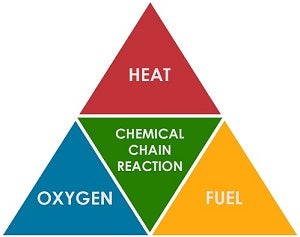Fire Safety Program

EH&S offers Fire Extinguisher Training, please contact EH&S at (202) 687-7172 or Safety and Health Consultation Requests online form
The fire and life safety program at GU involves numerous activities, programs, and procedures to help ensure that our campus is a safe place to work, live, and play. These program areas include fire prevention, fire suppression, emergency preparedness, preplanning, education, and response. The following information is provided as a general guideline for activities associated with fire and life safety. Additional information may be obtained by contacting EH&S or obtaining information from the EH&S website
FIRE TRIANGLE/TETRAHEDRON

The fire triangle illustrates the three main elements a fire needs to have in order to ignite: heat, fuel, and oxygen. A fire naturally occurs when the elements are present and combined in the right mixture. A fire can be prevented or extinguished by removing any one of the elements in the fire triangle.
The fire tetrahedron represents the addition of the chemical chain reaction component, to the three pre-existing elements in the fire triangle. Once a fire has started, the resulting exothermic chain reaction sustains the fire and allows it to continue until at least one of the elements of the fire is eliminated.
CLASSES OF FIRES
Class A fires are those which involve ordinary combustible materials such as wood, paper cardboard or cloth. These should be extinguished by using dry chemical extinguishers located in the hallways, common areas and laboratories. Water is effective in extinguishing this type of fire, however, water extinguishers are rarely found at GU.
Class B fires are those which involve flammable liquids, gases, oil, paint, and greases. Dry chemical extinguishers should be used to extinguish this type of fire. Note: Class B fires may re-ignite after being extinguished. Do not use water!
Class C fires are those which involve electricity. Dry chemical extinguishers should be used to extinguish a Class C fire. Do not use water! You risk further injury through shock or even electrocution!
Class D fires are those which involve combustible metals such as magnesium, sodium, lithium, cesium, phosphorous, or dust from any of these examples. Water can react with sodium and other alkali metals explosively. Understand that CO2 extinguishers are unlikely to be able to contain a Class D fire and are rarely found at GU. Do not use water!
Class K fires involving cooking media (fats, grease, and oils) in commercial cooking sites such as restaurants. These fire extinguishers work on the principle of saponification.
FIRE EXTINGUISHERS
There are two basic types of portable fire extinguishers found throughout GU. These include dry chemical and carbon dioxide extinguishers. These devices are to be used to extinguish small or beginning fires. Any employee wishing to receive training on a fire extinguisher should contact EH&S for information.
Carbon dioxide fire extinguishers are rated for Class B and C fires ONLY. The carbon dioxide is stored under pressure as a liquid and discharged as a gas. Extinguishing is accomplished by removing the oxygen from the fire. Carbon dioxide is a “clean” agent which will evaporate and leave no residue.
Dry chemical fire extinguishers are rated for Class A, B, or C fires. Optimal results are obtained by attacking the nearest edge of the fire and progressing forward, moving the nozzle rapidly with a side-to-side sweeping motion. Discharge should be continued after flames are extinguished (especially on Class A fires) to prevent possible re-ignition.
Please view the following P.A.S.S. video for directions on how to operate a dry chemical fire extinguisher.
FIRE EXTINGUISHER INSPECTION
OSHA regulation (29 CFR 1910.157), requires fire extinguishers to be visually inspected on a monthly basis. The extinguishers in the hallways are checked by Facilities Management. Each fire extinguisher located within the laboratory must be checked by laboratory staff members. The steps are described below, and should take about 30 seconds to complete.
To perform the monthly inspection:
- Ensure extinguisher is mounted in an easily accessible place, no debris or material in front.
- Ensure safety pin is in place and intact.
- Label is clear and undamaged.
- Handle is intact and not bent or broken.
- Pressure gauge indicator is in the green zone.
- Discharge hoses/nozzle is in good shape and not clogged, cracked, or broken
Lab staff should mark their initials and the condition of the extinguisher shell (OK or Good) on the inspection tag located around the neck of the extinguisher.
NOTE: When the indicator is in the red recharge zone or any damage is seen, please contact Facilities Management to replace the extinguisher (7-3432).
